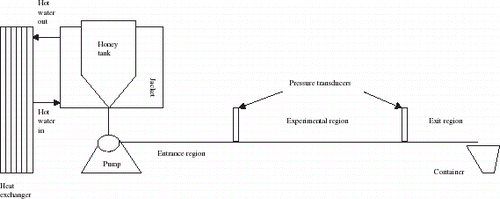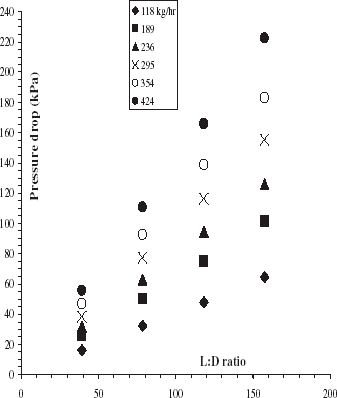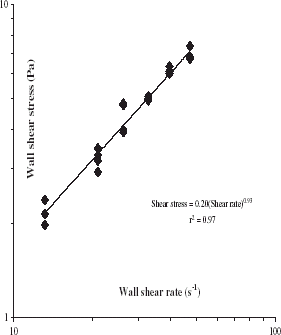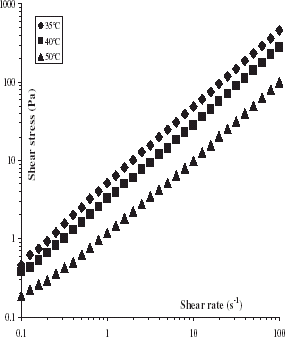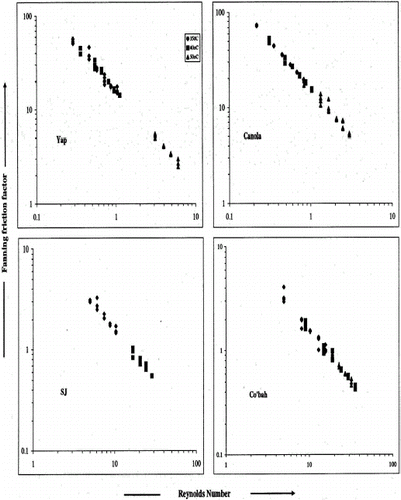Abstract
The pumping characteristics of four Australian honey samples were investigated in a straight pipe. Six flow rates (100–500 kg h−1) were studied at three temperatures (35–50°C). The pressure loss increased with an increase in the length of the pipe, as the flow rate was increased and as the temperature was reduced. In the 25.4 mm-pipe, the Reynolds number ranged from 0.2–32.0 and are substantially less than the critical value (2040–2180) for laminar condition in the system. The relationship between the wall shear stress and shear rate approximated power-law behaviour, and the power-law index was not significantly (p > 0.05) different from 1.0. The honey samples exhibited Newtonian behaviour at all the temperatures and this was confirmed by rheometric studies using Couette geometry. A friction chart was generated independent of temperature and the type of honey. An equation was developed to predict the pressure loss of the honey in a typical pipeline at any temperature once the viscosity–temperature relationship had been established.
Introduction
In the food industry, processing requirements can demand the transport of materials between operations. Liquid foods or ingredients are generally pumped, and the differential pressure at the ends aids flow.Citation1 During the flow over the walls of a pipe, friction is generated, and this impedes flow but the energy supplied by the pump must overcome this. In estimating the pumping requirements, losses due to friction have to be calculated, and a friction chart of the liquid for the system simplifies this. The friction chart is a plot of the friction factor against the Reynolds number.Citation1
Friction factors are key properties of pumpable materials, and they have been estimated for a number of foodsCitation2 Citation3 Citation4 Citation5 Citation6 Citation7 but no data on honey is available. Few studies that reported the pumping behaviour or requirements of honey either worked on diluted samplesCitation8 or did not generate friction and viscometric information.Citation9 Citation10 The importance of assessing frictional losses in pipeline design and selection of pumps has been discussed elsewhere.Citation1 Therefore, the objectives of this study were to investigate the pumping characteristics of four liquid Australian honeys, obtain their friction charts and compare their rheological parameters with rheometric data to guide predictive studies.
Theoretical Background
Generally, honey is a Newtonian liquid but non-Newtonian behaviour has been reported for some varieties.Citation11 Citation12 For pumping analysis, honey can be treated as a special case of power-law materials, and hence the power-law model (Eq. (Equation1)) can be applied:
For the flow of a power law fluid, the dimensionless generalized Reynolds number to characterize the flow in a pipeCitation1 is given by:
The average velocity is related to the flow rate as:
Reynolds number defines whether the flow is laminar or turbulent and there is a transition between the two. The transition is dependent on the material and the characteristics of the pipeline. Consequently, values in the range of 2000–4000 have been obtained for different systems, but SteffeCitation1 defined the critical Reynolds number for most purposes as:
Hence, when RePL (Eq. (Equation2)) is less than Recritical (Eq. (Equation4)), flow is regarded as laminar; a condition for the Rabinowitsch-Mooney equation to be applicable for the estimation of the shear rate at the wall:
Equation (Equation5) is a more convenient form of the Rabinowitsch-Mooney Eq. (Equation1), while the shear stress at the wall is described as:
The n′ in Eq. (Equation5) is the point slope of the log–log plot of τ
w
against the apparent wall shear rate , and it is equivalent to the power-law index for most fluids.Citation1 However, the true power-law index is better obtained by applying the power-law model (Eq. (Equation1)) to the τ
w
–γ
w
data.
Garcia and SteffeCitation13 have defined the friction factor, f, as:
Generally, in the laminar flow region, the Fanning friction factor is related to the Reynolds number as in Eq. (Equation10) but constants other than 16 have been obtained for some foods.Citation2
Other friction factors such as the Darcy friction factor (4f) are used in pipeline designs.Citation4 Equation (Equation10) holds irrespective of the pipe roughness but for flows in the turbulent region, the relationship between the friction factor and the Reynolds number is more complex and dependent on the nature of the surface.Citation1 Since honey is a viscous liquid, it is mostly pumped under laminar conditions and the Rabinowitsch-Mooney equation can be used to examine its rheological behaviour in a pipeline.
Materials and Methods
Materials
Four commercial honey samples (Table ) were obtained from a local processor (Capilano Honey Ltd., Richland, QLD 4077, Australia), held at 40°C for not less than seven days in closed plastic containers to dissolve any crystals. They were then held at about 30°C before the pumping studies.
Table 1 Selected properties of the honey samples
Pumping
The pumping set-up is as shown in Fig. . The mass flow rate was measured manually by weighing samples collected over a known time. Rotameter was not used because the samples were considered too viscous. The pipe (diameter 25.4 mm) was well insulated (Armaflex™, Armstrong-Nylex Pty. Ltd., Braeside, VIC. 3195, Australia) throughout its length to minimize temperature fluctuations, and three temperatures (°C), 35, 40, and 50 were studied. The honey was left for not less than 1h to equilibrate at the test temperature, which was maintained by hot water from a heat exchanger circulating in the jacket around the balance tank. Six flow rates (100–500 kg h−1) were studied using a screw “mono” pump (Mono Pumps (Aust.) Pty. Ltd., Kedron, QLD 4031, Australia), and four pressure transducers (ECEFast, Morningside, QLD 4170, Australia) were connected to the experimental part of the pipe. The first transducer was placed at about 2.5 m from the pump (>95D) while the last transducer was about 1.5 m (>1.5D) from the exit. SteffeCitation1 reported that pressure devices must be far away from the ends to minimize end effects while Adhikari and JindalCitation6 used distances that are identical to ours in their studies for negligible end effects.
The pressure transducers were calibrated between 30–50°C and a linear relationship (r 2 > 0.99) was obtained between pressure and voltage. A datalogger (DT 500, Data Electronic (Aust.) Pty. Ltd., Rowville, NSW 3178, Australia) was used to obtain the voltage every 10 s (DeTerminal™ software) for not less than 10 min per setting of the pump after 5 min equilibration; the minimum residence time averaged 2 min at the lowest flow rate. Average pressure drops were used for all the calculations, as the coefficient of variation was less than 15%.
Rheometric Studies
Rheometric studies were performed using a steady rate sweep test at shear rates (s−1) from 0.1 to 100 at 35, 40, and 50°C in the Rheometrics Dynamic Spectrometer II (Rheometric Scientific Inc., Piscataway, NJ 08854, USA). A Couette geometry was used consisting of a cup (diameter, 34 mm) and bob (diameter, 32 mm; length, 34 mm), while moisture loss during the analysis was prevented by a layer of silicone oil on the surface of the sample. Triplicate analysis was done for each condition, and results are presented as averages without error bars because the coefficient of variation was generally less than 10%. Samples were equilibrated for not less than 25 min at each set temperature, and the rheometer was calibrated as part of our periodic schedule using standard liquids.
Density
The density of the honey was measured by weighing a known volume and this was done at 35, 40, and 50°C. Distilled water was used as the standard.
Results and Discussion
Flow Rate
Irrespective of the temperature, the flow rate of the honey was linearly related (r 2 > 0.97) to the pump setting, and not significantly affected by the test temperature. Also, the test temperature did not significantly (p < 0.05) influence the density of the honey (Table ). Although an increase in temperature is expected to increase the flow rate of honey,Citation9 Citation10 it could be that the volumetric expansion of the honey samples within the range of temperature studied was negligible. In addition, apart from the Yap sample, which approximated the expected trend (not shown), the other samples had moisture content (Table ) more than 15%. They were possibly too watery for the temperature effect to be significant. From our measurement within this temperature range, the density of water averaged 1011 ± 10.6 kg m−3, and not substantially temperature dependent. However, it should be stressed that the density of the honeys is from 1410–1500 kg m−3, which is within the range reported in the literature.Citation14
Pressure Drop
Figure shows the relationship between pressure loss and L:D ratio (Bagley plots) for the Canola honey to indicate a typical trend. Generally, pressure loss increased with an increase in the length of the pipe, as the flow rate was increased and as the temperature was reduced. This trend is in line (Eq. (Equation9)) with the well-known Bagley analysis, and the inverse relationship of temperature with viscosity. The Bagley plot is normally used to estimate the correction for the entrance effect, and the procedures are described elsewhere.Citation1 Also, this author was of the opinion that if the position of the pressure device was much greater than the entrance length as calculated by Eq. (Equation11), then 98% of the flow would have developed before the measurement.
The maximum entrance length for the honey samples at all the temperatures are shown in Table . It can be observed that the length allowed for in this study, which is 2.5 m, more than catered for this and, therefore, entrance effect could be accepted to be negligible under all the conditions investigated. In other words, the flow was fully developed in this study before the pressures were measured. The slip correction is another important one. Slip results when a thin layer (boundary layer) of fluid, having a viscosity lower than that of the fluid, forms at the wall of a pipe or the wall of any viscometer.Citation1 To correct for this, pipes of different diameters are normally used in order to obtain the effective slip coefficient. Since only one diameter was investigated in this study, it was not possible to correct for slip. However, it is doubtful if slip would have been significant in pumping honey, which is generally a Newtonian liquid.
Table 2 Pumping and rheological parameters for the honey
Wall Shear Stress and Rate
From the range of Reynolds numbers in Table , laminar flow was obtained because they are all less than the critical values. Hence, the Rabinowitsch-Mooney equation was applied, and the relationship between the wall shear stress and rate for all the honeys, follows the power-law model as typified in Fig. for the Co’bah honey. The power-law parameters as well as the coefficients of determination are shown in Table . The power-law indices are not significantly (p < 0.05) different from 1.0, and this indicates that the honeys exhibited Newtonian behaviour during the pumping. The viscosity (or consistency index) is temperature dependent, which is expected. The Arrhenius model was suitable (r 2 > 0.95) in describing the temperature dependence but it is recognised that other models such as the Williams-Landel-Ferry (WLF) model could be better.Citation15 Citation16 Although the three levels of temperature studied limit any detailed analysis of the influence of temperature, the Canola honey exhibited the greatest sensitivity to temperature among the samples. The temperature coefficients (Ea /R) for the honey are Canola, 9810; Co’bah, 5900; Yap, 8270. No analysis was conducted on the SJ because there was no data at 50°C due to the pressure drop being lower than the sensitivity of the transducers at all the flow rates.
From the rheometric data, the shear stress–shear rate relationship also follows the power-law model (Fig. ), and the correlation was high (r 2 ≈ 1.00). Moreover, the power-law indices are essentially 1.0, and the viscosity is temperature dependent but numerically different from that estimated from the pipe. Although the range of the wall shear rate (10–50 s−1) during the pumping experiment is within that studied with the rheometer, the latter is more sensitive equipment with better controls, and so the difference could be due to this. Rozema and BeverlooCitation2 observed differences between their viscometric and pipe data. However, a major deduction from Table is that the rheological behaviour of the honey samples during pumping can be closely predicted by steady-state rheological studies. In addition, the pumping behaviour can possibly be predicted by oscillatory (dynamic) studies if the Cox-Merz ruleCitation17 applies.
Friction Chart
Figure shows the friction chart for the honey, and this should be valuable to the honey industry, which is a key member of the food and pharmaceutical industries. It can be observed that the relationship between the Fanning friction chart and Reynolds number is not dependent on the temperature and the type of honey (Table ). When the data for all the honeys were put together, the constant in Eq. (Equation10) equals 16.04 and the index for the Reynolds number is −1.0, while r 2 = 0.9983. Generally, while an increase in temperature decreases the friction factor because the liquid is less viscous and frictional drag is less pronounced, the Reynolds number increases because of the inverse relationship with viscosity.
Our observation that the type of liquid does not affect the relationship between the friction factor and Reynolds number in the laminar region is in line with published studies.Citation2 Citation5 Although more honey samples will have to be tested for confirmation of the trend reported here, our results support that Eq. (Equation10) can be applied to honey during pumping. The significance of this is that within the laminar region, the pressure drops during pumping of honey that exhibits Newtonian behaviour can be estimated by combining the above equations to yield Eq. (Equation12):
Equation (Equation12) assumes Arrhenius relationship with temperature but should the WLF model be preferred as demonstrated elsewhereCitation15 Citation16 for honey, then:
This implies that knowing the parameters of the Arrhenius or WLF model for the honey, the pressure drop can be estimated for a straight pipe of known length and diameter at the flow rate envisaged for processing. Therefore, using a tested predictive technique (e.g., artificial neural networks), a pressure chart can be generated to serve the honey processor. This will be valuable in estimating the pumping requirements of honey; an issue that is of utmost importance in the honey industry.
Conclusions
The four commercial honey samples that were studied behaved as Newtonian liquids during pumping, and this agreed with the rheometric information. The Rabinowitsch-Mooney equation was suitable in analyzing the pumping characteristics of the honey and the pressure loss was dependent on temperature, flow rate, length of pipeline, and the viscosity of the honey. Rearranging existing equations developed an equation that could be useful in estimating the loss in pressure when honey is pumped in a straight pipe. The general relationship between friction factor and Reynolds number was confirmed for the honey irrespective of the type and temperature. A typical pipeline consists of pipe fittings, having established the behaviour in a straight pipe studies on the flow of honey in fittings would complement this as well as an examination of slippage conditions during honey transport in pipelines.
Nomenclature
| γ | = |
Shear rate (s−1) |
| τ | = |
Shear stress (Pa) |
| μ 0 | = |
Viscosity (Pa s) at a reference temperature (T → ∞) |
| μ g | = |
Viscosity (Pa s) at the glass transition temperature |
| ΔP | = |
Pressure drop along the pipe (Pa) |
| γ w | = |
Shear rate at the wall (Pa) |
| τ w | = |
Shear stress at the wall (Pa) |
| A | = |
Constant |
| B | = |
Constant |
| C 1 | = |
Constant in the WLF model |
| C 2 | = |
Constant (°C, K) in the WLF model |
| D | = |
Diameter of the pipe (m) |
| ρ | = |
Density of the liquid (kg m−3) |
| E a | = |
Activation energy (J kg−1) |
| f | = |
Fanning friction factor |
| G | = |
Mass flow rate (kg s−1) |
| K | = |
Consistency index (Pa s n ) |
| L | = |
Length of the pipe (m) |
| n | = |
Power-law index |
| n′ | = |
Constant |
| Q | = |
Volumetric flow rate (m3 s−1) |
| R | = |
Universal gas constant (8.316 J kg−1 K−1) |
| r 2 | = |
Coefficient of determination |
| Recritical | = |
Critical Reynolds number |
| RePL | = |
Reynolds number of the power-law fluid |
| T | = |
Temperature (°C, K) |
| T g | = |
Glass transition temperature (°C, K) |
| v | = |
Average velocity of flow (m s−1) |
Acknowledgments
The authors are grateful to the Rural Industries Research Development Corporation, Honeybee Program for financial support, Capilano Honey Ltd., Brisbane for the samples, and Mr. Ross Millewski of the School of Land & Food Sciences for technical support.
References
- Steffe , J.F. 1996 . Rheological Methods in Food Process Engineering Michigan : Freeman Press .
- Rozema , H. and Beverloo , W.A. 1974 . Laminar, isothermal flow of non-Newtonian fluids in a circular pipe . Lebensm.-Wiss. u. Technol. , 7 : 223 – 228 .
- Rao , M.A. 1997 . Pumping power requirements and role of viscosity during agitation of concentrated orange juice . Trans. Citrus Eng. Conf. , 43 : 45 – 63 .
- Bojcic , P. , Khan , M.M.K. and Broadfoot , R. 1997 . Estimating pressure losses in pipe fittings at low Reynolds number . Proc. Aust. Soc. Sugar Cane Technol. , 9 : 479 – 484 .
- Telis-Romero , J. , Telis , V.R.N. and Yamashita , F. 1999 . Friction factors and rheological properties of orange juice . J. Food Eng. , 40 : 101 – 106 . [CROSSREF]
- Adhikari , B. and Jindal , V.K. 2000 . Artificial neural networks: a new tool for prediction of pressure drop of non-Newtonian fluid foods through tubes . J. Food Eng. , 46 : 43 – 51 . [CROSSREF]
- Telis-Romero , J. , Cabral , R.A.F. , Gabas , A.L. and Telis , V.R.N. 2001 . Rheological properties and fluid dynamics of coffee extract . J. Food Process Eng. , 24 : 217 – 230 .
- Jubran , B.A. and Hamdan , M.A. 1994 . Drag reduction using pure honey, with particular reference to biomedical engineering . Polymer Plastic Technol. Eng. , 33 : 37 – 53 .
- Macdonald , J.E. February 1963 . “ Honey pumps ” . In Gleanings in Bee Culture February , 85 – 87 .
- White , J.W. 1975 . “ Physical characteristics of honey ” . In Honey: A Comprehensive Survey Edited by: Crane , E. 207 – 239 . London : Morrison and Gibbs Ltd. .
- Munro , J.A. 1943 . The viscosity and thixotropy of honey . J. Entomol. , 36 : 769 – 777 .
- Pryce-Jones , J. 1953 . “ The rheology of honey ” . In Foodstuffs: Their Plasticity, Fluidity and Consistency Edited by: Scott-Blair , G.W. 148 – 176 . Amsterdam : North-Holland Publ. .
- Garcia , E.J. and Steffe , J.F. 1987 . Comparison of friction factor equation for non-Newtonian fluids in pipe . J. Food Process Eng. , 9 : 93 – 120 .
- Anon. Physical characteristics of honey, (accessed 10 December 1999) http://www.nhb.org/foodtech/physical.html
- Al-Malah , K.I.M. , Abu-Jdayil , B. , Zaitoun , S. and Ghzawi , A.A. 2001 . Application of WLF and Arrhenius kinetics to rheology of selected dark-colored honey . J. Food Process Eng. , 24 : 341 – 357 .
- Sopade , P.A. , Halley , P. , Bhandari , B. , D'Arcy , B. , Doebler , C. and Caffin , N. 2003 . The application of the Williams-Landel-Ferry model to the viscosity–temperature relationship of Australian honeys . J. Food Eng. , 56 : 67 – 75 . [CROSSREF]
- Macosko , C.W. 1994 . “ Viscous liquid ” . In Rheology: Principles, Measurements and Applications Edited by: Macosko , C.W. 65 – 108 . New York : Wiley-VCH Inc. .
